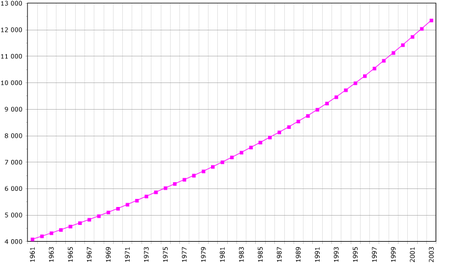- Demographics of Guatemala
-
The demographics of Guatemala are diverse, constituting primarily of Mestizos, Amerindians and Europeans. About 60% of the population speak Spanish, with nearly all of the rest speaking Amerindian languages.
According to the CIA World Fact Book, Mestizo (mixed Amerindian-Spanish - in local Spanish called Ladino) and European made 59.4% of the population, and K'iche 9.1%, Kaqchikel 8.4%, Mam 7.9%, Q'eqchi 6.3%, other Mayan 8.6%, indigenous non-Mayan 0.2%, other 0.1%.[1] Therefore, 40% of the population is Amerindian. Pure European population is not known because the country combines mestizos with whites.
Most of Guatemala's population is rural, though urbanization is accelerating. The predominant religion is Roman Catholicism, once the main faith of the population, into which many indigenous Guatemalans have incorporated traditional forms of worship. Protestantism and traditional Maya religions are practiced by an estimated 40% and 1% of the population, respectively.
Though the official language is Spanish, it is often the second language among the indigenous population. However, the Peace Accords signed in December 1996 provide for the translation of some official documents and voting materials into several indigenous languages (see summary of main substantive accords).
Racial stratification is complex and fluid in Guatemalan politics, culture and identity. Guatemala City, the largest city in Central America, is home to over 3 million inhabitants.
Other racial groups include small numbers of Afro-Guatemalans and Garifuna of mixed African and indigenous Caribbean origins who live in the country's Eastern end. Asians, mostly of Chinese descent are descendants of farm workers and railroad laborers in the early 20th century. And thousands who are Middle Easterner descendants: Arabs, Lebanese, Palestinians, Syrians and Turks came to Guatemala after World War I.
In 1900, Guatemala had a population of just 885,000. [2] Over the course of the twentieth century, the population of the country grew by a factor of fourteen. No other western hemisphere country saw such rapid growth. This has brought on difficulties for Guatemala as more people puts pressure in the nation's economic progress in a country where 70% live in dire poverty, and political stability was weakened by an inability to have effective population growth programs.
Over a million Guatemalan emigrants went to the US in the 1980s and 1990s for a better life mostly because of the Civil War. Guatemalans are the 2nd largest national subgroup of Central Americans in the USA numbering 1,081,858 in 2009(after the El Salvadorans).[2]
The largest population of Guatemalans is in Los Angeles, but there are also established Guatemalan communities in Dallas, Houston, Miami, New York City, San Diego, San Francisco area, and Washington, DC. There are also Guatemalan immigrants living abroad in Canada, Mexico, Venezuela, Argentina, Europe, Palestine, Saudi Arabia, Egypt, Japan, South Korea and Australia as well.[citation needed]
Contents
CIA World Factbook demographic statistics
The following demographic statistics are from the CIA World Factbook, unless otherwise indicated.
Population
13,824,463 (July 2011 est.)
Age structure
0-14 years: 38.1% (male 2,678,340/female 2,582,472)
15-64 years: 58% (male 3,889,573/female 4,130,698)
65 years and over: 3.9% (male 252,108/female 291,272)Population growth rate
1.986% (2011 est.)
Birth rate
26.96 births/1,000 population (2011 est.)
Death rate
4.98 deaths/1,000 population (2011 est.)
Net migration rate
-2.12 migrant(s)/1,000 population (2011 est.)
Sex ratio
at birth: 1.05 male(s)/female
under 15 years: 1.033 male(s)/female
15-64 years: 0.941 male(s)/female
65 years and over: 0.861 male(s)/female
total population: 0.974 male(s)/female (2007 est.)Infant mortality rate
29.77 deaths/1,000 live births
Life expectancy at birth
total population: 70.88 years
male: 69.03 years
female: 72.83 years (2011 est.)Total fertility rate
- 3.27 children born/woman (2011 est.)
- 4.4 children born/woman (2007 est.)
Nationality
noun: Guatemalan(s)
adjective: GuatemalanEthnic groups
- Amerindian - K'iche' 9.1%, Kaqchikel 8.4%, Mam 7.9% and Q'eqchi'i 6.3%, other Mayan 8.6%, indigenous non-Mayan 0.2% - 40.5%[3]
- Mestizo (mixed Amerindian and Spanish - locally called Ladino) and White European- 59.4%[3]
- Other - Garífuna, descended from Black Africans and indigenous peoples from St. Vincent's, live mainly in Livingston and Puerto Barrios, and other blacks and mulattos; Asians, mostly of Chinese descent, and also a growing Korean community in Guatemala City and in nearby Mixco, currently numbering about 10,000.[4] - 3.9%
Religions
Languages
- Spanish - 60%
- Amerindian languages (23 officially recognized languages, all from the Mayan language family except Garifuna and Xinca) - 40%:
Literacy
definition: age 15 and over can read and write
total population: 76.03%
male: 79.89%
female: 72.54% (2002 census)References
- ^ https://www.cia.gov/library/publications/the-world-factbook/geos/gt.html#People
- ^ US Census Bureau: 2009 American Community Survey 1-Year Estimates HISPANIC OR LATINO ORIGIN BY SPECIFIC ORIGIN
- ^ a b "Guatemala". World Factbook. CIA. https://www.cia.gov/library/publications/the-world-factbook/geos/gt.html#People. Retrieved 2007-12-17.
- ^ [1]
 Languages of Guatemala
Languages of GuatemalaDemographics of North America Sovereign states Dependencies and
other territories- Anguilla
- Aruba
- Bermuda
- Bonaire
- British Virgin Islands
- Cayman Islands
- Curaçao
- Greenland
- Guadeloupe
- Martinique
- Montserrat
- Puerto Rico
- Saint Barthélemy
- Saint Martin
- Saint Pierre and Miquelon
- Saba
- Sint Eustatius
- Sint Maarten
- Turks and Caicos Islands
- United States Virgin Islands
Categories:- Guatemalan society
- Demographics by country
Wikimedia Foundation. 2010.

